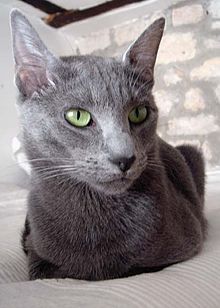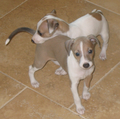Dilute gene
As dilution gene ( engl. Dilute "dilute") or dilution gene are referred to in different animal species different genes whose mutation to a lightening of the intensity of the coat color result.
Myosin 5a gene
Myosin 5A is responsible for the transport of the melanosomes (pigment granules) to the tips of the cell extensions of the melanocytes (pigment-producing cells). There they are transferred to the cells that are supposed to be colored afterwards. The number of melanosomes is normal, but they clump together so that the color is lightened. By concentrating in irregular groupings, the light absorption is reduced and black fur appears gray. In addition, they change the shape of the melanocytes and shrink the melanin granules, which increases the lightening.
Rats
The dilute-opisthotonus (dop) mutation in rats affects the myosin 5A gene.
human
A mutation of the same gene leads to Griscelli syndrome in humans .
mouse
In the mouse, the mutation of the myosin 5a gene location is called the dilute lethal 20J protein gene.
MLPH
MLPH is a gene that, like myosin 5a, plays a role in the transport of melanosomes. It leads to a lightening of the coat color for very similar reasons as this one.
Cats

In cats , the dilution gene is a mutation in MLPH. Three alleles are known, D (wild type, full color, dominant), d (diluted) and D m (modified diluted, which is most likely located at a different gene location).
When diluted, black becomes blue, chocolate lilac, cinnamon fawn and red becomes cream. The modified, diluted colors are caramel (from blue), taupe (from lilac) and apricot (from cream). The modified dilution of fawn does not appear to have manifested as yet.
The diluted color is highly valued by cat breeders , some breeds of cats such as the Carthusian cat , the Korat cat and the Russian blue have to show the diluted color, i.e. carry the dilution genetically.
dogs
In dogs, a mutation in the MLPH locus known as the dilute gene causes eumelanin to lighten while pheomelanin remains almost unchanged.
Appearance
The light brown caused by pheomelanin is hardly influenced by the color tones that occur in the dog's fur . In contrast, black is lightened to a gray called "blue" and dark brown is lightened to the typical color of the Weimaraner.
Animals that would have black or dark brown areas in their fur without the dilute gene are lightened precisely in these areas, while the light brown areas are hardly affected.
Great Danes that have been lightened from black to blue by the dilute gene
Dobermann : black with tan at the back, blue with tan at the front - it can be seen that the light brown areas have hardly been lightened
Blue and light brown brindle dog
genetics
The dilute gene is abbreviated with d and is recessive compared to the wild-type allele D for the unlit color. A dog's predisposition to this gene can be determined using a gene test that is now available. In some of the animals lightened by the dilute gene, the mutation is associated with hair loss and changes in the hair roots. Since not all breeds in which the gene occurs have these problems, it is assumed that there could be a second previously unknown mutation of the MLPH gene. However, this has not yet been proven for certain.
Every dog has two copies of this gene - one from the father and one from the mother. A distinction is made between the following combinations ( genotypes ):
- DD: Both father and mother inherited the wild-type allele. The fur is not lightened.
- Dd: Either the father or mother inherited the allele for the diluted color expression. The thinning of the paint is not visible, however - the dog has the same coat color as a DD dog.
- dd: Father and mother inherited the allele for the diluted color expression. The black areas of the fur are lightened to blue, dogs also lightened by the brown gene take on the color typical of the Weimaraner.
According to Mendel's rules , 25% of the puppies receive the gene combination dd if both mother and father carry the gene combination Dd in them.
Races
In the dog breeds German Pinscher and Dobermann , the color lightening due to the dilute gene is undesirable in Germany. The black coat color is lightened to "gray" - the so-called blue or isabel-colored (dilution of brown) Pinscher or Doberman is created. Along with the color lightening effect, these (and other) breeds are susceptible to hair loss and skin inflammation. Only dogs with the gene combination DD are free from this disposition and are preferably used in pinscher breeding. See also Blue dog syndrome and
In other breeds such as the Great Dane , on the other hand, the gene is quite desirable, since blue dogs correspond to the breed standard.
mouse
In mice, the MLPH gene is responsible for the "Leaden" mutation associated with lightened coat color.
SLC36A1: The champagne gene in horses
Horses that have been lightened by the champagne gene are, depending on the underlying color, golden with a white or chocolate-colored mane or they have the typical champagne color with a slightly darker mane and tail.
OCA4 - MATP
The MATP gene (membrane associated transporter protein gene) corresponds to the gene that is mutated in oculocutaneous albinism type 4 in humans.
horse
The horse's cream gene is often listed as a dilute gene and is due to a MATP mutation.
Unknown locus
horse
- In the horse, the dun locus is known as the dilute gene and causes a lightening that is associated with the eel line and the zebra crossing. This corresponds to the wild type of the Przewalski horse and occurs in many, primarily original, pony breeds. The recessive allele d is not highlighted and is more common in most domestic horse breeds than the wild type of the gene.
- Pearl is a gene that lighten the color of horses to a light sand color or a light gray. The locus is not yet known here either.
Dog: Dilute-Gen of the Italian Greyhound and I-Gen
Deer colored dogs can arise in different ways. They carry at least once the allele a y of the agouti locus or the allele e of the extension locus twice. Both forms of deer color can also appear diluted.
Since the MLPH gene hardly changes pheomelanin, a gene i that has not yet been genetically investigated is held responsible for this if it is heterozygous (only once). If the gene i is present twice, the dog is lightened to white. This form of lightening occurs, for example, in the Golden Retriever , the Labrador Retriever , the White Shepherd and the Chihuahua .
Deer-colored golden retriever, allele combination II, not lightened. This color is referred to as dark golden for this breed.
Chihuahua : black with sand-colored branding, allele combination Ii
Chihuahua : black with white brand, allele combination ii
In addition, there is obviously another dilute gene in the Italian greyhound , which also clears up pheomelanin and is not identical to the MLPH gene.
swell
- ↑ a b c d e Krista Siebel: Analysis of genetic variants of loci for coat color and their relationships to color phenotype and quantitative performance characteristics in pigs. Inaugural dissertation . Institute for Animal Science at the Humboldt University in Berlin, 2001.
- ↑ Y. Takagishi, Y. Murata: myosin Va mutation in rats is an animal model for the syndrome human hereditary neurological disease, Griscelli type 1. In: Ann NY Acad Sci. 2006 Nov; 1086, pp. 66-80. PMID 17185506
- ↑ G. Menasche, CH Ho, O. Sanal, J. Feldmann, I. Tezcan, F. Ersoy, A. Houdusse, A. Fischer, G. de Saint Basile: Griscelli syndrome restricted to hypopigmentation results from a melanophilin defect (GS3 ) or a MYO5A F exon deletion (GS1). In: J Clin Invest. 112 (3), 2003 Aug, pp. 450-456. Erratum In: J Clin Invest. 115 (4), 2005 Apr, p. 1100. PMID 12897212
- ↑ NCBI: Myo5a myosin Va (Mus musculus). GeneID: 17918 . Status: 01-Apr-2007.
- ↑ a b c U. Philipp, H. Hamann, L. Mecklenburg, S. Nishino, E. Mignot, AR Gunzel-Apel, SM Schmutz, T. Leeb: Polymorphisms within the canine MLPH genes are associated with dilute coat color in dogs . In: BMC Genet. 6, 2005 Jun 16, p. 34. PMID 15960853 .
- ↑ a b c U. Philipp, P. Quignon, A. Scott, C. Andre, M. Breen, T. Leeb: Chromosomal assignment of the canine melanophilin gene (MLPH): a candidate gene for coat color dilution in Pinschers. In: J Hered. 96 (7), 2005, pp. 774-776. Epub 2005 Jun 15, PMID 15958794
- ↑ a b Y. Ishida, VA David, E. Eizirik, AA Schaffer, BA Neelam, ME Roelke, SS Hannah, O'brien SJ, Menotti-Raymond M: A homozygous single-base deletion in MLPH causes the dilute coat color phenotype in the domestic cat. In: Genomics. 88 (6), 2006 Dec, pp. 698-705. Epub 2006 Jul 24. PMID 16860533
- ↑ C. Drogemuller, U. Philipp, B. Haase, AR Gunzel-Apel, T. Leeb: A Noncoding Melanophilin Gene (MLPH) SNP at the Splice Donor of Exon 1 Represents a Candidate Causal Mutation for Coat Color Dilution in Dogs. In: J Hered. 2007 Aug 3; PMID 17519392
- ↑ Lydia E. Matesic, Richard Yip, Andreé E. Reuss, Deborah A. Swing, T. Norene O'Sullivan, Colin F. Fletcher, Neal G. Copeland, Nancy A. Jenkins: Mutations in Mlph, encoding a member of the Rab effector family, cause the melanosome transport defects observed in leaden mice- In: Proc Natl Acad Sci USA . 98 (18), 2001 August 28, pp. 10238-10243. PMID 11504925
- ↑ D. Cook, S. Brooks, R. Bellone, E. Bailey: Missense Mutation in Exon 2 of SLC36A1 Responsible for Champagne Dilution in Horses. In: PLoS Genet . 2008 Sep 19; 4 (9), p. E1000195. PMID 18802473
- ↑ Denis Mariat, Sead Taourit, Gérard Guérin: A mutation in the MATP gene causes the cream coat color in the horse. In: Genet. Sel. Evol. 35 (2003), pp. 119-133. 119 © INRA, EDP Sciences, 2003. doi: 10.1051 / gse: 2002039
- ↑ a b c Sheila Schmutz: Diluted or Pale Colors (English)
- ↑ a b SM dirt, TG Berryere: Genes affecting coat color and pattern in domestic dogs: a review. In: Anim Genet. 38 (6), 2007 Dec, pp. 539-549. PMID 18052939














